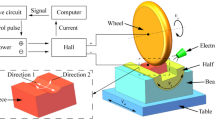Abstract
Electrolytic in-process dressing (ELID) grinding is a new method for achieving ultraprecision surface on hard and brittle materials. In ELID grinding, pulsed direct current voltage is applied on the metal-bonded diamond wheels to ensure constant protrusion of sharp cutting grits throughout the grinding cycle. The peak dressing voltage is kept constant irrespective of the wheel sharpness in conventional ELID grinding, which may lead to overdressing of the grinding wheel. Grinding force ratio (which is also known as K value) is an indicator for the grit sharpness. In this paper, a new approach of wheel dressing has been proposed where the peak dressing voltage is varied according to the change in the K value during grinding. A Kistler three-component dynamometer has been used to monitor the grinding force ratio in real time for this purpose. The methodology to implement the new “dressing-on-demand” concept has been discussed thoroughly in this paper. The experimental comparison with the conventional ELID grinding has also been carried out to prove the advantages of the proposed system.
Similar content being viewed by others
Reference
Murata R, Okano K, Tsutsumi C (1985) Grinding of structural ceramics. Milton C Shaw Grinding Symposium 16:261–272
Ohmori H, Nakagawa T (1990) Mirror surface grinding of silicon wafer with electrolytic in-process dressing. Ann CIRP 39(1):329–332. doi:10.1016/S0007-8506(07)61065-8
Ohmori H, Nakagawa T (1997) Utilization of nonlinear conditions in precision grinding with ELID (Electrolytic In-Process Dressing) for fabrication of hard material components. Ann CIRP 46(1):261–264. doi:10.1016/S0007-8506(07)60821-X
Bandyopadhyay BP, Ohmori H, Takahashi I (1997) Efficient and stable grinding of ceramics by electrolytic in-process dressing (ELID). J Mater Process Technol 66(1):18–24. doi:10.1016/S0924-0136(96)02454-5
Ohmori H, Takahashi I, Bandyopadhyay BP (1996) Ultra-precision grinding of structural ceramics by electrolytic in-process dressing (ELID) grinding. J Mater Process Technol 57:272–277. doi:10.1016/0924-0136(95)02079-9
Rahman M, Lim HS, Neo KS, Kumar AS, Wong YS, Li XP (2007) Tool-based nanofinishing and micromachining. J Mater Process Technol 185:2–16. doi:10.1016/j.jmatprotec.2006.03.121
Marinescu ID, Rowe WB, Dimitrov B, Inasaki I (2004) Tribology of abrasive machining process. Noyes, USA, p 311
Lim HS, Fathima K, Kumar AS, Rahman M (2002) A fundamental study on the mechanism of electrolytic in-process dressing (ELID) grinding. Int J Mach Tools Manuf 42:935–943. doi:10.1016/S0890-6955(02)00023-8
Stephenson DJ, Sun X, Zervos C (2005) A study on ELID ultra precision grinding of optical glass with acoustic emission. Int J Mach Tools Manuf 46:1053–1063. doi:10.1016/j.ijmachtools.2005.08.013
Zhang C, Ohmori H, Marinescu I, Kato T (2001) Grinding of ceramic coatings with cast iron bond diamond wheels, a comparative study: ELID and rotary dresser. Int J Adv Manuf Technol 18:545–552. doi:10.1007/s001700170031
Malkin S (1971) The wear of grinding wheels, Part 1—attritious wear. Trans ASME J Eng Ind 93:1120–1128
Marinescu ID, Rowe WB, Dimitrov B, Inasaki I (2004) Tribology of abrasive machining process. Noyes, USA, p 148
Kramer D, Rehsteiner F (1999) ECD (Electrochemical In-Process Controlled Dressing) a new method for grinding of modern high performance cutting materials to highest quality. Ann CIRP 48(1):265–268. doi:10.1016/S0007-8506(07)63180-1
Kwak JS, Ha MK (2004) Detection of dressing time using the grinding force signal based on the discrete wavelet decomposition. Int J Adv Manuf Technol 23:87–92. doi:10.1007/s00170-003-1556-7
Ju KH, Kim HS, Hong SW, Park CH (2001) Monitoring of grinding wheel wear in surface grinding process by using laser scanning micrometer. Int J Korean Soc Precis Eng 2:81–86
Amin AM, Maksoud TMA (2000) Monitoring of the condition of diamond grinding wheels using acoustic emission technique. J Mater Process Technol 101:292–297. doi:10.1016/S0924-0136(00)00433-7
Liao TW, Ting CF, Qu J, Blau PJ (2007) A wavelet-based methodology for grinding wheel condition monitoring. Int J Mach Tools Manuf 47:580–592. doi:10.1016/j.ijmachtools.2006.05.008
Rabinowicz E (1995) Friction and wear of materials. Wiley, Hoboken, p 81
Sin H, Saka N, Suh NP (1979) Abrasive wear mechanism and the grit size effect. Wear 55:163–190. doi:10.1016/0043-1648(79)90188-1
Saleh T, Rahman MS, Lim HS, Rahman M (2007) Development and performance evaluation of an ultra precision ELID grinding machine. J Mater Process Technol 192:287–291. doi:10.1016/j.jmatprotec.2007.04.034
Author information
Authors and Affiliations
Corresponding author
Rights and permissions
About this article
Cite this article
Saleh, T., Bishwas, I. & Rahman, M. Efficient dressing of the wheel in ELID grinding by controllable voltage with force feed back. Int J Adv Manuf Technol 46, 123–130 (2010). https://doi.org/10.1007/s00170-009-2076-x
Received:
Accepted:
Published:
Issue Date:
DOI: https://doi.org/10.1007/s00170-009-2076-x




